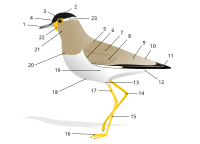
Photo from wikipedia
Integration of the rookery connectivity, which includes historical connections among rookeries, and migratory connectivity assessing dispersal or migratory routes of marine animals are important for understanding dispersal and/or migration and… Click to show full abstract
Integration of the rookery connectivity, which includes historical connections among rookeries, and migratory connectivity assessing dispersal or migratory routes of marine animals are important for understanding dispersal and/or migration and its effect on the formation of genetic population structure. The migratory nature and long-distance movement of sea turtles have been reported, while natal philopatry has been suggested by genetic differentiation among rookeries within a relatively narrow geographic scale. Therefore, we hypothesize that contemporary long-distance movement has a limited effect on colonization in new rookeries. This study compared the genetic relationships among rookeries and between the rookeries and foraging grounds of green turtles (Chelonia mydas) in Southeast Asia. Mitochondrial control region sequences of 333 turtles from 11 rookeries were newly determined, and combination with previously reported Indo-Pacific rookeries indicated the presence of a genetic barrier in the Torres Strait and Celebes Sea (i.e. Philippines–Sulawesi). On the other hand, an analysis of newly collected 107 turtles from seven foraging sites and mixed stock analyses indicated contemporary movement across this historical genetic barrier, from Micronesian rookeries to foraging grounds in the Celebes Sea (i.e. Sipadan Island and Tun Sakaran Marine Park). Isolation by distance was generally supported for relationships among rookeries, and the high migratory connectivity did not result in a lower genetic distance between rookeries than predicted from geographic distance. Differences between rookery connectivity and migratory connectivity in green turtles in Southeast Asia are likely due to migration to natal regions after long-distance movement.
Journal Title: Marine Biology
Year Published: 2018
Link to full text (if available)
Share on Social Media: Sign Up to like & get
recommendations!